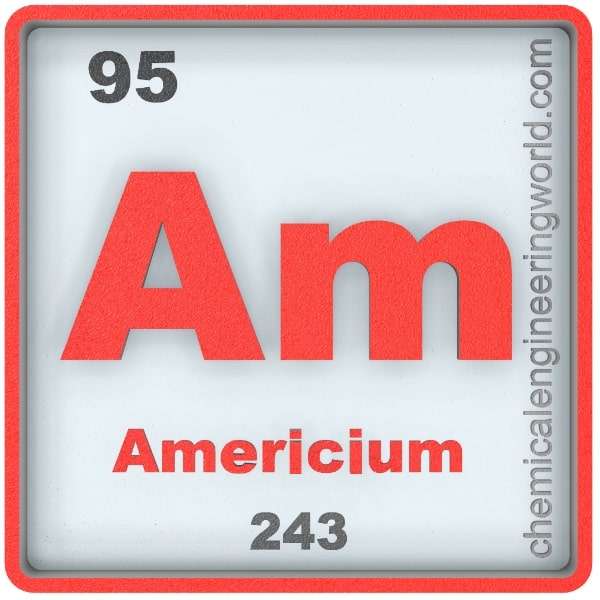Americum Element Properties and Information

Americum Element Properties and Information
Americum is 95th element on the periodic table. Elements are arranged in the periodic table on the basis of the atomic number. Atomic number is the number of protons in the nucleus of the atom. Americum has an atomic number of 95. It is located in the Group ‘Actinides’ and Period 7 of the periodic table of elements. It is denoted by the symbol ‘Am’. The name is derived from the country, America.
Glenn Seaborg, Ralph James, Leon Morgan, and Albert Ghiorso intentionally made Americum for the first time in 1944 by bombarding plutonium with neutrons in a nuclear reactor. The key word is ‘intentionally’ because even though earlier to this time, scientists were not looking for a new element, americium was still part of the decay chain. Americum is speculated to have been existed on Earth in natural nuclear reactors of Oklo, Gabon for millions of years.
Physical Properties
- Americum is a synthetic radioactive transuranic element which finds its place in the actinide series.
- The atomic mass of americium is (243).
- The melting point of americium is 994°C.
- The boiling point of americium is 2607°C.
- The density of americium is 13670 in S.I. units at 20°C.
- Fresh americium has a silvery-white lustrous appearance.
- The intrinsic alpha particle activity of americium damages its crystal structure.
- Americum is paramagnetic in nature.
- Nearly 19 isotopes of americium are known so far.
Chemical Properties
- Americum surface tarnishes when it is exposed to air.
- Americum metal readily reacts with the oxygen.
- Americum dissolves easily in aqueous solutions.
- Most stable americium compounds display an oxidation state of +3.
- Americum(III) compounds are chemically similar to lanthanide(III) compounds.
- Americum compounds are also observed to display an oxidation state of +2, +4, +5, +6, and +7.
- Americum compounds which have an oxidation state greater than +4 are very strong oxidising agents.
- Americum is observed to form halides, pnictides, chalcogenides, silicides, borides, organoamericum compounds.
Methods of Production
Nucleosynthesis: Uranium-238 bombarded with neutrons to form uranium-239, this undergoes beta decay to form neptunium-239 which further undergoes beta decay to yield plutonium-239. To make Americium: plutonium-239 is bombarded with neutrons, after it captures 2 neutrons, plutonium-241 is formed. Plutonium-241 undergoes beta decay to form Americum-241.
Relevance in Chemical & Related Industries
Americum has no relevant large-scale use in process industries.
Relevance in Other Industries
- Smoke Detectors: Americum is used in house-hold ionization-type smoke detectors, it preferred over radium-226 because americm-241 emits 5 times less alpha particles and relatively lesser gamma radiation.
- Neutron Source: Americum-241 pressed with beryllium acts as an excellent alpha source. One of the areas of application is spectrometer.
Health Effects on Exposure
Absorption: Americum which enters the body accumulates in the bones. The presence of such radiation for a long period of time harms the bones.
Effects on Exposure
Nuclear weapon Testing: Americum decays very slowly, hence with each testing the concentration is gradually increasing in the soils. When animals get exposed to large amounts of americium, their organs gets damaged. The americium which is absorbed by the plants from the soil, gets stored in that part of plant which the herbivorous animals don’t eat. The americium which is absorbed by fish does not accumulate in the edible portion of the fish. Thus, americium doesn’t accumulate in the food chain.
References:
https://en.wikipedia.org/wiki/Americium
https://www.lenntech.com/periodic/elements/am.htm
https://www.rsc.org/periodic-table/element/95/americium
































